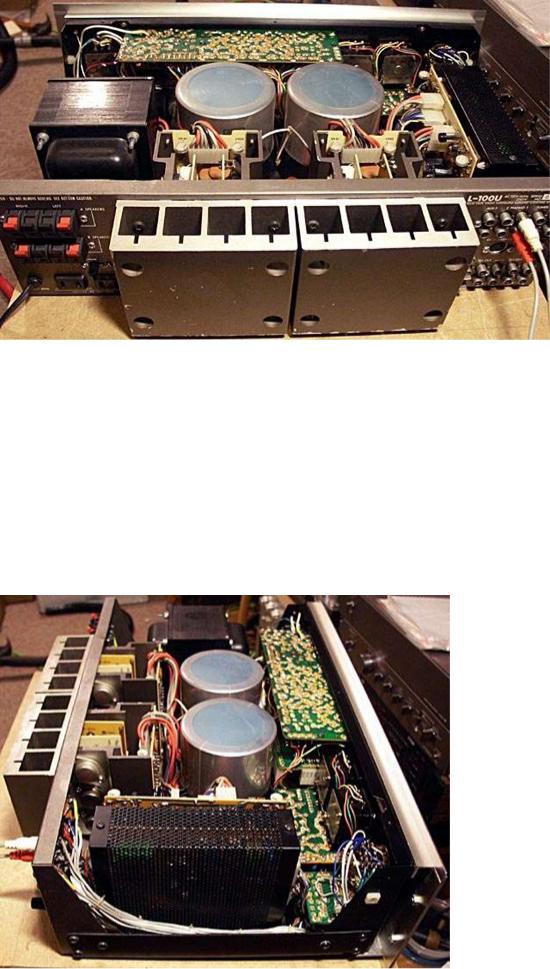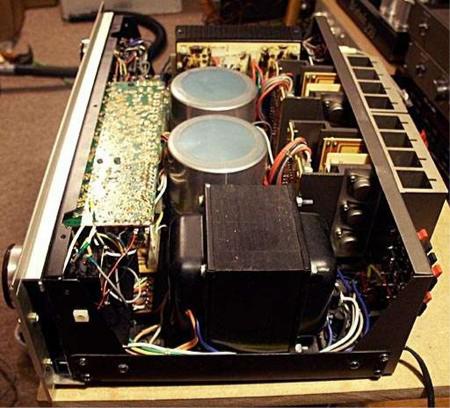Luxman L-100 Brochure

http://www.thevintageknob.org/LUXMAN/L100/L100.html#
Luxman L -100
Although never a major player, Luxman is the oldest Japanese HiFi manufacturer, with a long history of innovations in the field, as well as a unique status of a mass-market manufacturer, that never the less has a line of truly high end components. The L-100 was Luxman's top of the line in 1976 to 1978, at which time it retailed for a whopping $995. It was the pinnacle of what luxman's engineers could do with solid state at the time (and pretty much pinnacle, period), equipped with every feature one could imagine.
FEATURES
Very conservatively rated at 110WPC into 8 ohms, it drives low impedances with ease. This is an amplifier that is all about sound, but also has a ton of features. Two Phono inputs are provided with variable gain, loading and Luxman's exclusive linear equalizer. A tuner (with variable sensitivity control, located in the back), two AUX inputs, and two tape inputs (tape 2 with RCA and DIN interconnect) are also provided. The power and pre sections are separable by removing jumpers on the rear panel. Signal routing alowes for separate dub and monitor setup for tape decks.

The filter and tone control section is feature rich, but completely defeatable never the less. The bass and treble controls have three center frequencies each - 150, 300, 600Hz and 1.5k, 3k and 6kHz respectively. The controls themselves are thick film on ceramic substrate switches rather than pots, with 1dB detents. A bass boost is provided instead of the more traditional loudness control, defeatable in conjunction with the tone controls. The filter section has a low/subsonic filter with 10Hz and 70Hz, and a high filter with 7kHz and 12kHz settings. This section is followed by a mono-stereo-reverse switch and a switch to drive only the left or right channels (this is usable for simulcast FM).

The volume control section is quite unique in having a dual volume and muting control - along with the main volume control, which is again a thick film on ceramics switched attenuator, rather than the traditional potentiometer, there is a separate attenuating pot that sets the 'baseline' volume inside a 20dB range. This has a coaxial balance control. In addition, there is Luxman's unique touch-muting, which is defeatable via a switch on the rear panel. Touching the central metal part on the volume control activates a 15dB attenuator and lights the muting LED. Touching the outer metal ring of the volume control deactivates the 15dB attenuation and switches off the LED. The control is 'touch-speed' sensitive - it only activates when you quickly touch the metal ("bounce your finger off it"). The power amp section has switches for two speaker pairs. Build quality is amongst the best offered at the time, and excellent (or better!) for today's standards. Fair warning: it weighs a TON.
DETAILED INFO
This amp was the top of the line in 1976, and one of the most expensive integrated amplifiers of the day. The price is no doubt due to the selection of components that could be considered to verge on esoteric for the times. For instance, the audio signal only passes through foil capacitors, and the number of these has been limited to as few as possible.
The amplifier features a truly high-end phono section, which, however only accepts MM cartridges (and with fairly large output voltages at that), although I expect a high output MC will work fine assuming the gain of the phono stage is set to it's highest. Instead of the variable capacitance control, luxman includes continiously variable loading (from 10k to 100k), and their exclusive linear equalizer. This is a special type of low phase shift filter that effectively tilts the whole responce towards the low or high end (depending on setting). 5 settings are provided, flat plus approx. 2dB and 4dB tilt in either direction. The influence of the control is quite subtle. The Phono section has no less than 4 power supplies, uses selected low noise transistors and precision capacitors, and resides in a separate shielded box, as far as possible from the power transformer.
The power amps are two separate modules, powered by a huge transformer and two positively enormous filter caps - these computer grade caps from Nippon Chemicon had to be ordered specially, the dimensions are custom to the L-100. One eBay user described them as being as big as Saturn V booster rockets, and the description fits! Needless to say, the power reserve of this amp is extraordinary.
The amplifier is a dual differential symetrical amplifier, as advanced as you get for the times - even today some have not caught on yet. Two pairs of power transistors share the output current with an additional pair of post-drivers - the output configuration uses a three stages. A comprehensive array of protection features
